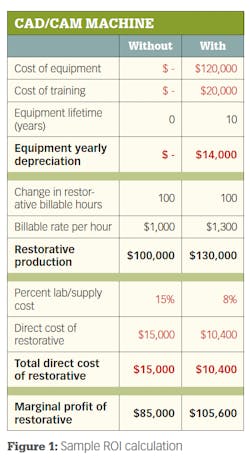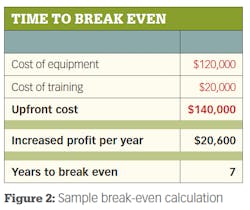Venture capital money flowing into many different areas of health care, including dental care, has increased more than 50% year over year.1 So love it or hate it, you can benefit from venture capital interest and infusion into the dental field.
The influx of cash presents opportunities for both newer and more experienced practitioners. If you’re looking to retire soon, the market is hot and you may have an easy out if yours is a self-owned practice. If you’re an independent practice owner, you have a unique opportunity to see how an entity that focuses decision-making primarily on profit evaluates options. This is unlike what dental has historically prioritized: patient care.
Also by Nicole Rose Yen:
Accounting is more than your taxes
Calculations and considerations when purchasing patient records
How do you attract the attention, and fortune, of venture capital? Start with a clearly defined end-goal. This sounds simple enough, but practice owners are often reluctant to clearly articulate their goals, as they feel it is too restricting. It’s not the case for venture capital. You can always pivot, but if you don’t know where you’re aiming, you might miss out on success. As venture capital firms generally exist to make money, we can learn a lot from how they evaluate opportunities and then select certain opportunities to turn into reality. The number one rule of venture capital is to start with the end-goals defined.
Defining your end-goals
If you haven’t thought about your end-goals, start by listing when you would like to retire, your ideal annual income at retirement, and then the amount of time you’d like to spend in the office each week leading to that retirement date. Once you have those numbers listed, rank them in order of importance. These clearly defined goals will be a measuring stick for you to go back to as opportunities arise. Find this compass and stick to it. Does this mean that you have to commit to only 25 hours in the office each week? Absolutely not. But if you don’t hold some accountability to goals, you won’t be able to coordinate your efforts.
Example scenarios
What does this look like in practice? Let’s review a scenario of someone early in their career with a primary goal to spend no more than 30 hours in the clinic and a secondary goal to increase profit, but not at the expense of more time in the clinic. A supply representative comes into the dental office and notices that they don’t have a scanner, and they haven’t incorporated CAD/CAM into the office. Should the new dentist get just the scanner or the complete system? Experience from other clinics shows that CAD/CAM systems not only require a higher upfront investment in the cost of equipment, but also a significant amount of technical training. However, being early in the dentist’s career, the high upfront costs and the technical training work to their advantage to meet their primary and secondary goals—resulting in reduced chair time per restorative patient and also in reduced lab costs.2
On the other hand, for a dentist poised to retire (not taking into consideration strategic positioning for the exit strategy from their clinic), the investment will likely just eat into the 30 hours allotted clinical hours without much time to realize the reward. Stay true to your goals.
Not only does a venture capitalist have a clearly defined end-goal; they also have thresholds for consideration. We all have heard of the main one: return on investment (ROI). If a venture capitalist is eyeing your clinic, industry standards suggest they plan on coming up on the deal by at least 35%. This doesn’t mean that you can ignore budgeting, but it does mean that if you are going to invest time and money into a second clinic, piece of equipment, or new staff, you should have a calculated ROI and a plan of execution to get the numbers to pencil.
After you’ve defined your goal, find an opportunity that you’re excited about and calculate ROI. Let’s use the CAD/CAM machine. Start by listing all the variables that having a CAD/CAM machine would change with an estimate of how much would change, and ignore those it would not change (for example, administrative salaries, rent, etc). See Figure 1 for a sample calculation.
Before you execute, remember that we’re not just asking if this will make more money—we are asking if it is aligned with your goals. What other milestones do you want to achieve and on what timeline? Will you need the capital tied up in the equipment before the break-even point? These milestones come with their own evaluations, but we can calculate how long it takes to earn your money back on the CAD/CAM machine (figure 2).
Once you've evaluated the opportunity and determined it is a good fit for your goal, it’s time to execute. You’ve already done the calculations, so the next step is checking the projected to actual and adjusting from there. Keeping tabs on the financial performance of your investments will not only help you know where you are but also help you in your ROI estimates for future investments.
While some consider the infusion of venture capital into dental (and health care in a wider scope) the decline of patient care, it is an opportunity that the patient-focused independent practice owner can use to improve their own practice. When presented with your next investment opportunity, remember to consider not only whether it has the potential to increase revenue and improve patient satisfaction, but most importantly, whether it aligns with your defined end-goals.
Editor's note: This article appeared in the May 2022 print edition of Dental Economics magazine. Dentists in North America are eligible for a complimentary print subscription. Sign up here.
References
1. Anderson DG, Potter MJ, Morris DE. Healthcare venture investing: how to succeed in a white-hot market. November 24, 2021. https://www.hfma.org/topics/hfm/2021/december/healthcare-venture-investing--how-to-succeed-in-a-white-hot-mark.html
2. Rodgers C. CAD/CAM technology. February 1, 2013. https://www.dentaleconomics.com/money/article/16393531/cadcam-technology
About the Author
Nicole Rose Yen
Nicole Rose Yen is an advisor at Breakaway Bookkeeping + Advising, focused on turning quantitative metrics into actionable strategies for small-business owners specializing in dentistry. She uses tech integration to streamline business inefficiencies and provides strategic planning and financial insights for her clients. As a numbers whiz, Yen finds joy in creating solutions-oriented business plans for her clients. Contact her for information on bookkeeping and financial planning at [email protected] or (503) 610-8349.
Updated July 29, 2022



